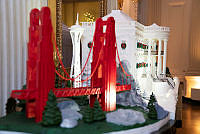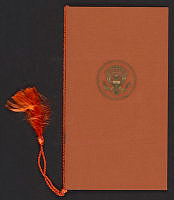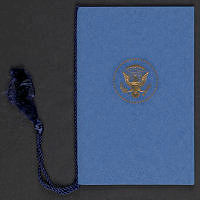Rubenstein Center Scholarship
Hawai'i and the White House
On November 23, 1993, President Bill Clinton signed Public Law 103-150, also known as the "Apology Resolution," in the Oval Office—a rare example of bipartisan accountability for a previous wrongdoing at the highest level of government.1 The subject? America’s involvement in the overthrow of the Hawaiian monarchy one hundred years earlier. But to fully understand this legislation's significance, one must understand the long history of Western influence in Hawai’i.
Europeans first encountered the people of the Hawaiian Islands when British cartographer Captain James Cook landed there in 1778. The next several decades proved pivotal in Hawaiian history. In 1810, King Kamehameha I unified the islands into one kingdom.2 Christian missionaries arrived in the 1820s, and later, merchants and tradesmen began to settle in the kingdom. The latter were drawn to the rich natural resources on the islands, chief among them sugar.3 Realizing Hawai’i’s profitability, as well as its strategic military and trade location in the Pacific Ocean, American politicians and businessmen began to chip away at the power of the monarchy during the nineteenth century.

Eighteenth Century Map of Hawai’i (then called the Sandwich Islands)
Library of CongressIn fact, the Kingdom of Hawai’i was so integral in U.S. foreign affairs that Hawaiian King Kalākaua was the first foreign leader to be honored with a State Dinner at the White House. President Ulysses S. Grant hosted King Kalākaua on December 22, 1874, where he was entertained lavishly “not only with all the civic honors the country [could] constitutionally bestow, but with open arms.”4
King Kalākaua’s visit to the United States resulted in the Treaty of Reciprocity, ratified in 1875, which allowed for duty-free importation of Hawaiian products in the United States and vice versa.5 But this opening of trade marked the beginning of the downfall of the Hawaiian monarchy.

Here, King Kalākaua and President Ulysses S. Grant meet in the Blue Room during his 1874 State Visit
White House Collection/White House Historical AssociationOn July 6, 1887, a powerful group of White settlers, businessmen, and missionary descendants forced King Kalākaua to sign a new constitution under duress.6 Known today as the “Bayonet Constitution,” the document significantly altered power dynamics in the kingdom, favoring American settlers rather than Native Hawaiians. It marked a key step in a long process of Hawaiian annexation.
"And, now, without any provocation on the part of the king, having matured their plans in secret, the men of foreign birth rose one day en masse, called a public meeting, and forced the king, without any appeal to the suffrages of the people, to sign a constitution of their own preparation, a document which deprived the sovereign of all power, made him a mere tool in their hands, and practically took away the franchise from the Hawaiian race." -Queen Lili'uokalani7
When King Kalākaua died in 1891, his sister, Lili'uokalani, became queen. After learning that she sought a new constitution that would re-empower Hawaiians, on January 17, 1893, a group backed by U.S. troops and U.S. Minister to the Hawaiian Kingdom John Stevens staged a coup. Meanwhile, President Benjamin Harrison, by then in the final weeks of his administration, supported a treaty for the annexation of Hawai’i as it moved through Congress.8

Queen Lili'uokalani, ca. 1891
Library of CongressBut the deposed queen had a friend moving back into the White House: President Grover Cleveland. The two initially met at the Executive Mansion in 1887 during Cleveland’s first term in office. The president and First Lady Frances Cleveland honored then-Princess Lili'uokalani and her sister-in-law Queen Kapi'olani with a State Dinner.9 Within days of his second Inauguration in 1893, President Cleveland showed his support for the queen. He withdrew the annexation treaty for “reexamination” and sent statesmen James H. Blount to Hawai’i to investigate the U.S. government’s role in the overthrow of the monarchy.10
In his December 1893 report to Congress, President Cleveland revealed that Blount’s findings showed “beyond all question that the constitutional Government of Hawai’i had been subverted with the active aid of our representative to that Government and through the intimidation caused by the presence of an armed naval force of the United States…”11 He also proposed that Lili'uokalani should be reinstalled as queen, though Congress rejected the idea.
“A substantial wrong has thus been done which a due regard for our national character as well as the rights of the injured people requires we should endeavor to repair.” -President Grover Cleveland12

In 1994, the people of Hawai’i dedicated President Grover Cleveland Court (pictured) “with appreciation and aloha” to the president for withdrawing the annexation treaty. It is located near ‘Iolani Palace in Honolulu.
billsoPHOTO, FlickrDespite Cleveland’s support for the monarchy, the Republic of Hawaii was established in 1894. Essentially, the Republic intended to govern until the Unites States could achieve formal annexation.13 After an attempted revolt by her allies the following year, Queen Lili'uokalani was forced to formally abdicate her throne and imprisoned for almost eight months in ‘Iolani Palace.14

‘Iolani Palace was home to Hawaiian monarchs in Honolulu and later the site of the queen’s imprisonment.
Library of CongressAfter her release, she resumed the fight for sovereignty, making several lobbying trips to Washington, D.C. Just before President Cleveland left the White House in 1897, the queen called on him in the Red Room.15 Newspapers reported “the President greeted the ex-queen most kindly” while the queen on “behalf of the Hawaiian race, thanked the President for his withdrawal of the annexation treaty.”16
Cleveland’s pro-annexation successor, President William McKinley, was not so friendly to the Hawaiian queen. During one attempt to call on him at the White House in June 1897, newspapers reported: “When it was made known that ex-Queen Lili'uokalani was one of the members of the party the White House clerk raised his hands deprecatingly: ‘Impossible. The Queen must not come to the White House at this time. Her visit would cause too much gossip.’”17 The following month, she met the president at a public reception inside the White House, though reports indicate that they did not discuss politics.18 Interestingly, Queen Lili'uokalani dispelled myths of hard feelings in her memoir, writing that their White House meeting included “a most delightful conversation.”19
Any attempts to sway President McKinley were in vain. Amid the expansionist fervor of the War of 1898 (better known as the Spanish-American War), Hawai’i’s location in the Pacific proved too advantageous for the United States to ignore.20 Despite continued annexation resistance by the queen, including the submission of a petition signed by over half of the Native Hawaiian population, President William McKinley signed the “Newlands Resolution,” officially annexing the Hawaiian Islands on July 7, 1898.21 Queen Lili'uokalani responded with a letter protesting the “assertion of ownership by the United States of America of the so-called Hawaiian Crown Islands.”22 Through she continued to fight the U.S. government for restitution until her death in 1917, Hawai’i remained out of her reach.23

Hawaiian Flag Being Replaced with American Flag, 1898
Hawaii State ArchivesAs a U.S. territory, Hawai’i lacked authority, funding, and representation in the federal government, leading residents to push for statehood throughout the twentieth century.24 At the same time, the territory had strategic, military value in the Pacific, acting as a defensive and offensive midpoint between Asia and the United States.25 As Japan became a stronger (and more threatening) global power, the United States Navy bolstered their presence on the islands, eventually moving the U.S. Pacific Fleet from California to Pearl Harbor, Hawai’i.26 On December 7, 1941, Japanese forces attacked Pearl Harbor, propelling the U.S. into World War II.

Japanese attack on Pearl Harbor, 1941
Franklin D. Roosevelt Presidential Library/NARASoon, a new conflict amplified calls for statehood: the Cold War. Hawaiian statehood countered claims of American imperialism and colonialism leveled by the Soviet Union, framing the United States as a multicultural, inclusive country. Throughout the Cold War, Soviet propaganda often featured America’s fraught race relations, highlighting the hypocrisy of America’s pursuit of freedom and democracy abroad while African Americans and other communities of color fought for basic rights at home.27
Hawaiian statehood thus provided an opportunity to prove the Soviets wrong—one that President Dwight D. Eisenhower supported from the outset of his presidency. In his words, “In Hawaii you have an economy that is self-supporting, there is a large population, and on top of that, they delivered a record in World War Two that to my mind clearly entitles them to the privileges of statehood.”28 Following a successful statehood referendum on the islands, President Eisenhower signed a bipartisan bill admitting Hawai’i to the Union as the fiftieth U.S. state on August 21, 1959.29

Eisenhower signs the Hawaii Admission Act of 1959 in the Cabinet Room
Dwight D. Eisenhower Presidential Library and Museum/NARABut the unjust history of Hawai’i’s treatment could not be ignored. One hundred years after the overthrow of the Kingdom of Hawai’i in 1993, Congress passed legislation recognizing and apologizing for the role of the United States government in the illegal overthrown of the kingdom. Hawaiian senators Daniel Inouye and Daniel Akaka sponsored the legislation. In Senator Inouye’s words: “While we cannot change history, we can acknowledge responsibility.”30 President Bill Clinton signed the Apology Resolution in the Oval Office, bringing the story of Hawai’i and the White House full circle.31

Clinton signs an official apology on November 23, 1993, surrounded by Vice President Al Gore, Senator Daniel Inouye, Representative Patsy Mink, Representative Neil Abercrombie, and Senator Daniel Akaka
William J. Clinton Presidential Library and Museum/NARASome Hawaiians saw the legislation as an important symbolic step toward reconciliation, while others sought a larger movement for redress, including financial reparations and the return of crown lands seized by the federal government.32 To this day, some Hawaiians seek full sovereignty, citing the illegal overthrow of the monarchy as justification for independence.33
Many thanks to 'Iolani Palace Historian Zita Cup Choy for providing suggestions and contributions to this article.



































